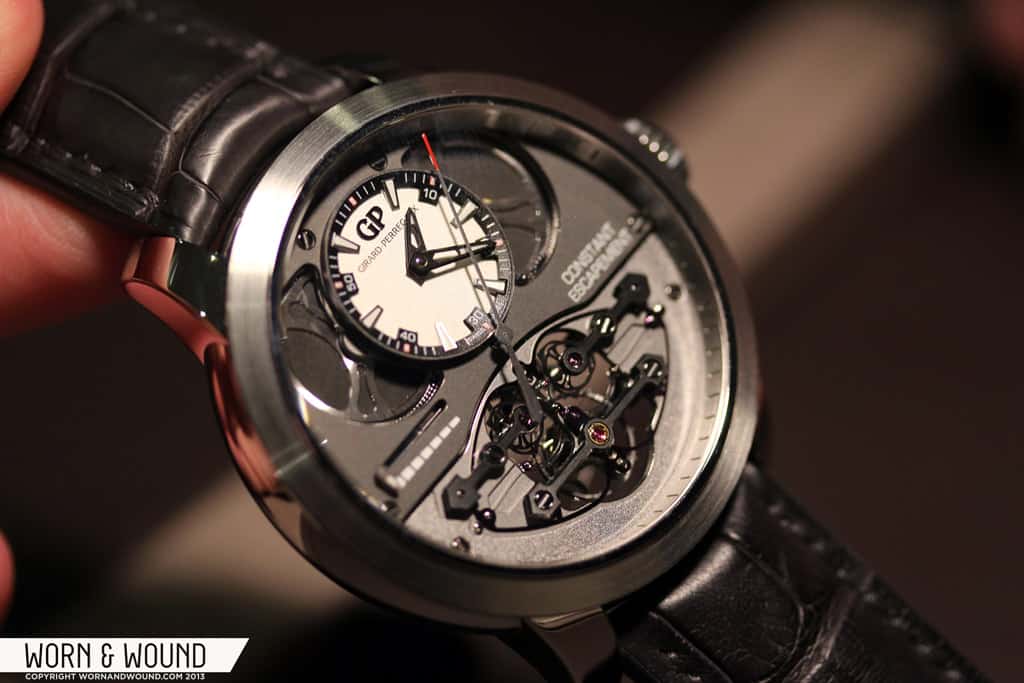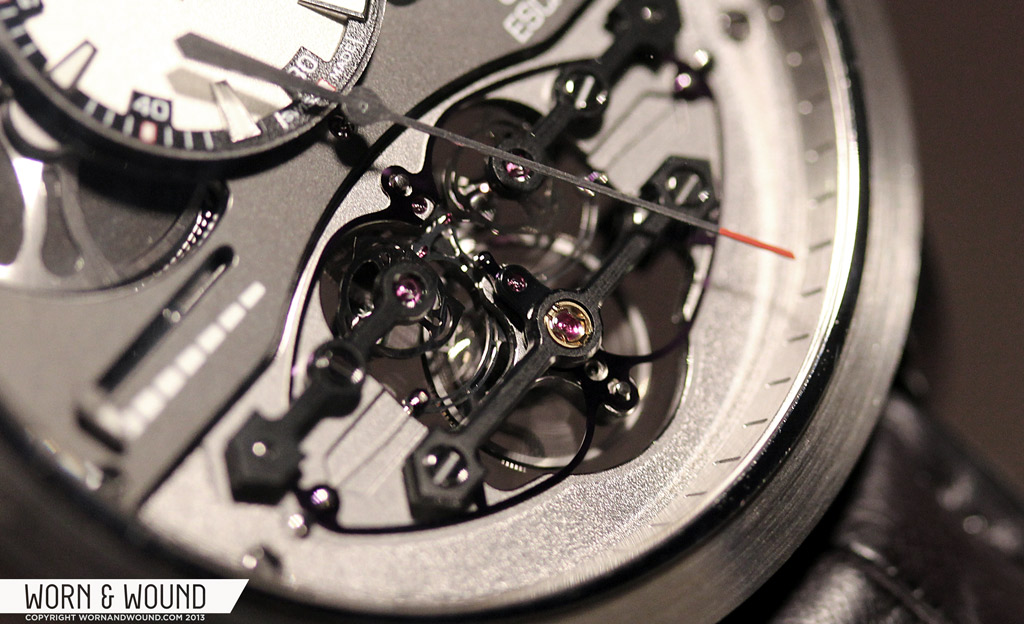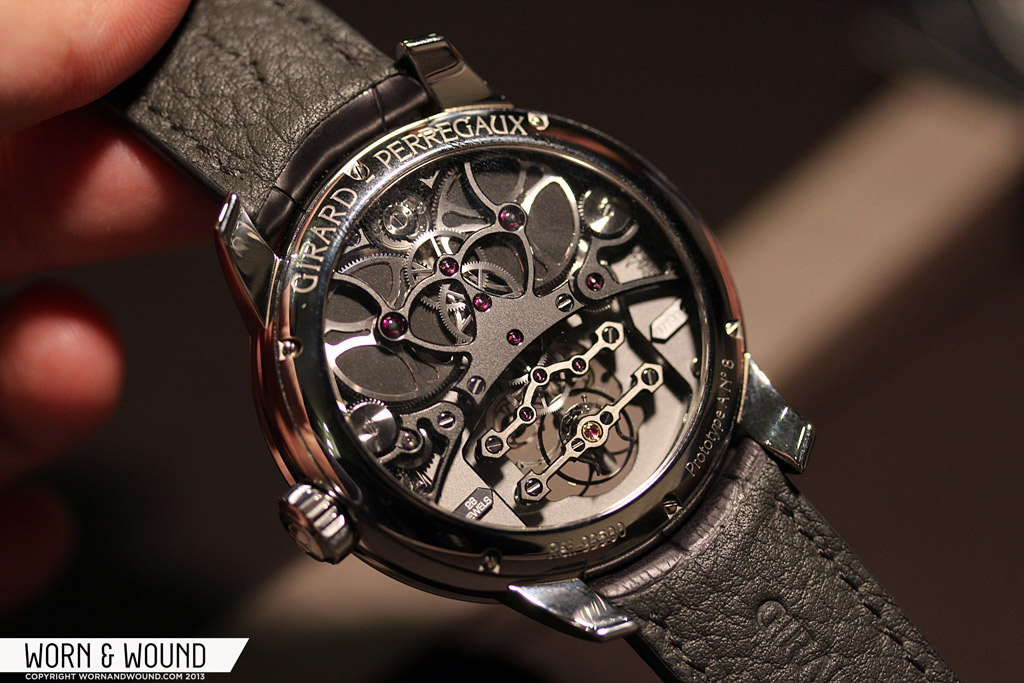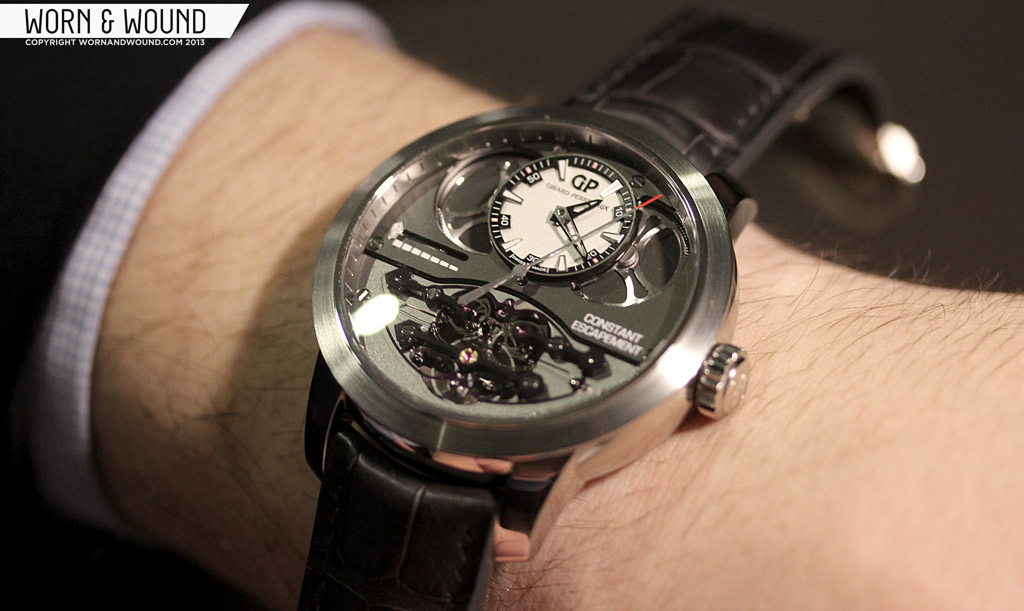One of the great things about BaselWorld is being able to see and touch watches that are normally pretty off limits…in fact, there might only be a small handful of those watches in existence to begin with. Naturally, these watches tend to fall into the category of Haute Horology, and are not about to make one of our buyer’s guides, as they cost tens of, to hundreds of thousands of dollars. One such watch that we had the distinct pleasure of spending some time with was the Girard-Perregaux Constant Escapement.
This piece of mechanical art is currently the crowning achievement of the brand, as the elaborate movement that powers it has a novel mechanism that solves an age-old problem: that of supplying constant force to the balance wheel. The basic gist of this issue, as I understand it, is that one a typical movement the barrel, or mainspring, will supply more energy when fully wound then when close to unwound. Logically, this would push the balance wheel to move faster when there is more tension thus creating a situation of varying accuracy; this is called the curve of amplitude. In order solve this, there needs to be “constant force” supplied to the balance wheel regardless of the tension in the barrels.
There are various solutions that have been implemented, but Girard-Perregaux’s is unique and claimed to be even more accurate. When you take a look at the beautiful beast of a watch that houses this movement, you will notice on the bottom half of the dial a set of bridges in an oval frame. Running from one tip of the oval to the other is single piece of tech, the brilliant innovation, the triple-flux capacitor (if you will) of the Constant Escapement that when combined with a new escapement design, supplies constant force. It’s a single blade of silicon that is 14-microns thin and acts as an intermediary energy storage system. As the watch runs you can see this thread snap back and forth, giving an instantaneous, precise and continuous pulse of energy. Yeah, that’s all confusing, so watch the video below, which should illuminate some.
In the end, you have a watch with a simple analog solution to an age-old problem that takes very modern manufacturing methods to create. The first watch to utilize this escapement speaks to this mix of modern and classic with an open design that emphasizes the movement as a whole. It’s a massive watch, 48mm in diameter, that doesn’t feel like a time-piece so much as a city in your hand. The movement is mind-numbingly gorgeous. Elaborate, bizarre and fascinating, the symmetrical design is fitted with blackened bridges and prominently featured rubies. It’s not a movement that speaks to hours of hand finishing in the form of swirls and engravings, though it certainly every millimeter has been finished in someway. Rather, it looks modern and almost rugged. If they had told me that it was also capable of withstanding the heat of atmospheric re-entry, I probably would have believed them.
The dial also does not emote classical music, white wigs and velour coats, but something industrial and functional (that video above is practically scored with dub-step). The minute and hour hands are relegated to a small sub-dial on the top of half of main dial, and is flanked by the skeletonized barrels on either side, which supply an astounding 7 days of power. “Dial” is actually not really the best way to describe the area, as it’s really all movement. As such, the dial, hour and minute hand feel like a gauge that taps into the movement’s output. In the center of the “top-side” is a large seconds hand with a red tip and the bottom half is the mesmerizing “constant escapement”.
Like a tourbillon, the Constant Escapement is just one of those things that is hypnotic. The flexing of the silicon blade, the motion of the twin escapements, the smooth spin of the balance all come together to be a mechanical performance on a near invisible scale that is doing the incredible: keeping time. GP plans on producing about 10 of these watches, though the movement and mechanism will be utilized in other designs down the line. Expect a healthy price tag of around $100k.
So, the question remains, why should this matter to you, a collector of affordable watches? Well… Brands like Girard-Perregaux have the resources to do R&D of novel designs to solve problems like that of constant force. Though you are not likely to see the effect of this in the next watch you buy, who knows down the line if this isn’t something that will be implemented in more affordable watches when the fabrication of such a mechanism is less costly? Unlike a minute repeater (not that we don’t love those) the Constant Escapement is actually trying to and succeeding at improving the accuracy of the mechanical watch.
Furthermore, watches like the Constant Escapement are almost like a form of alchemy. They are the product of brilliant engineers and designers who want to fight against physics to make something more perfect. Though the result is very industrial, the process and drive are oddly human, and I cant help but admire such a strive.
by Zach Weiss









 Featured Videos
Featured Videos











